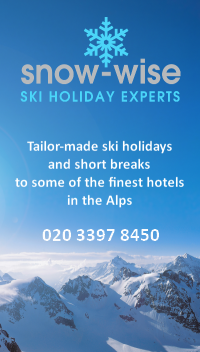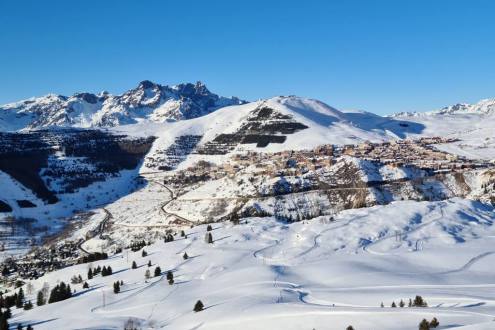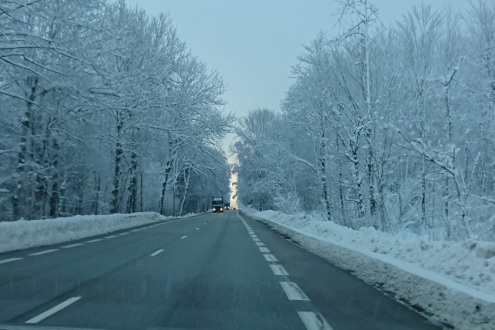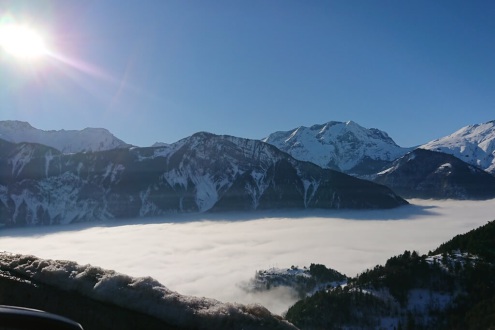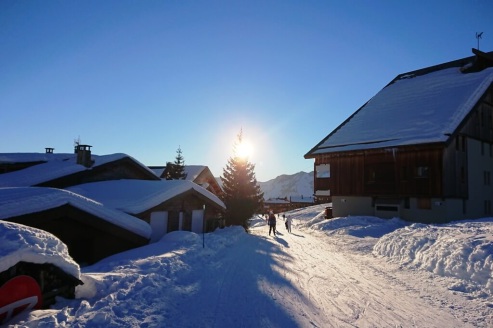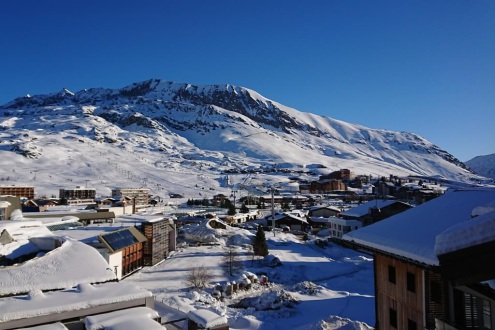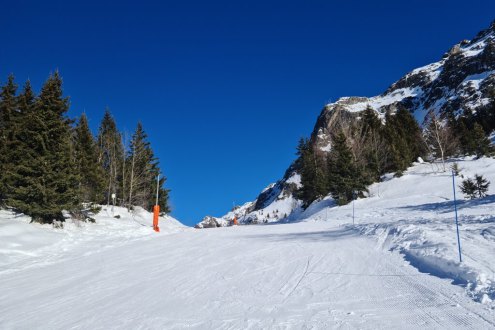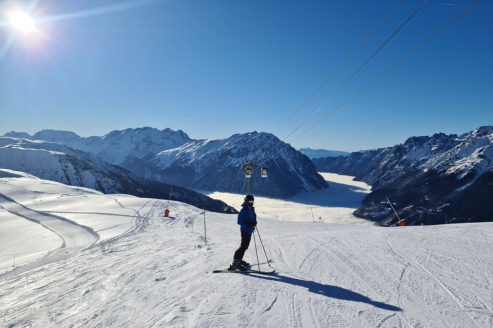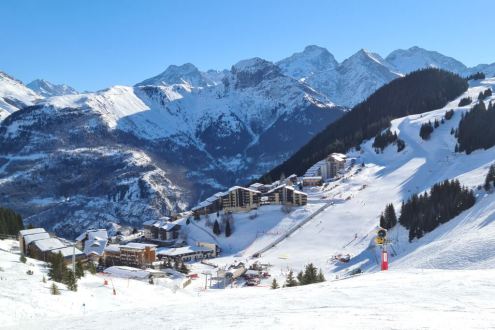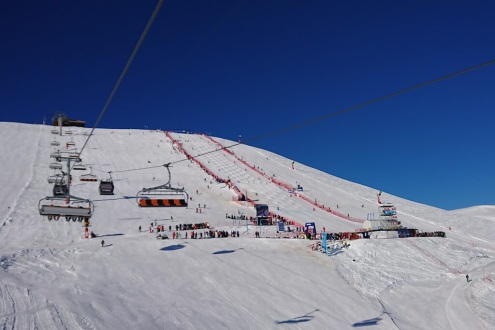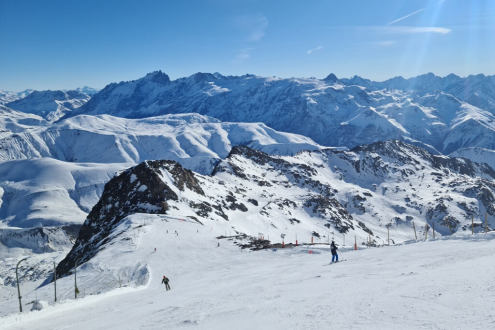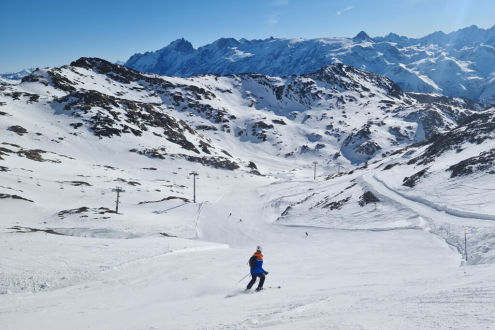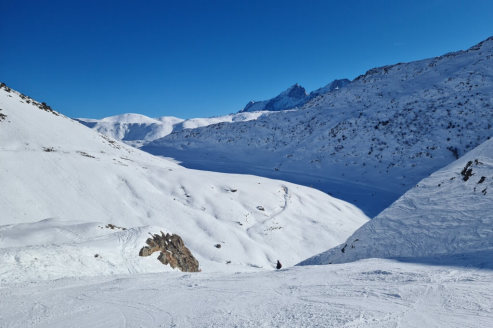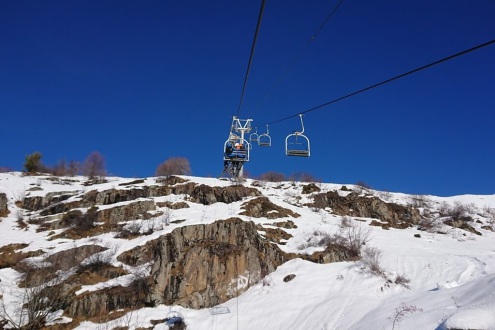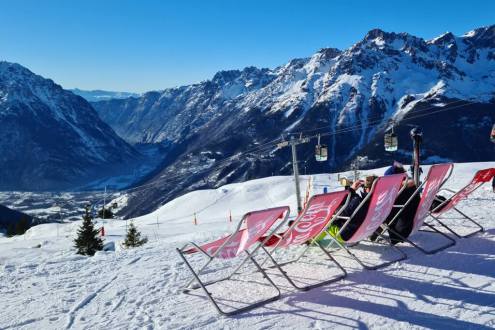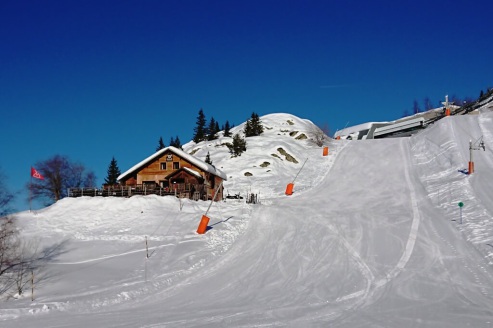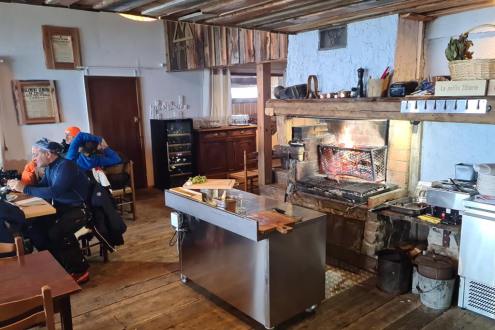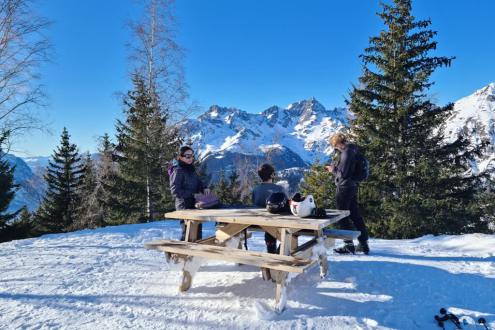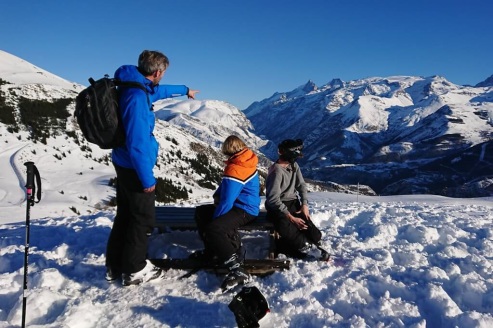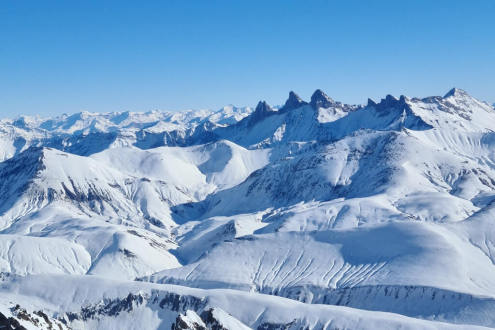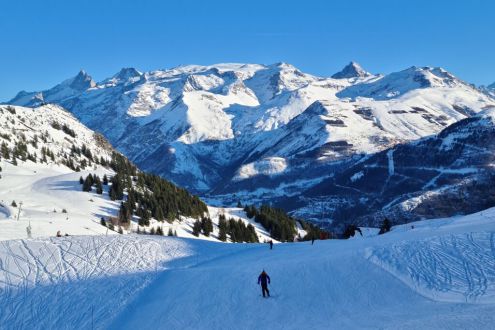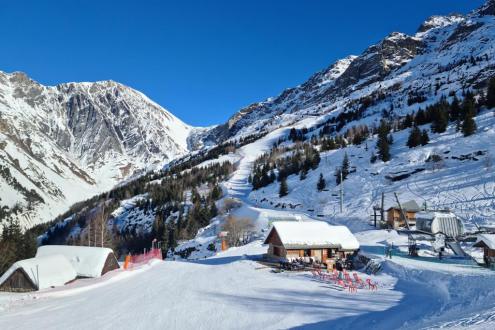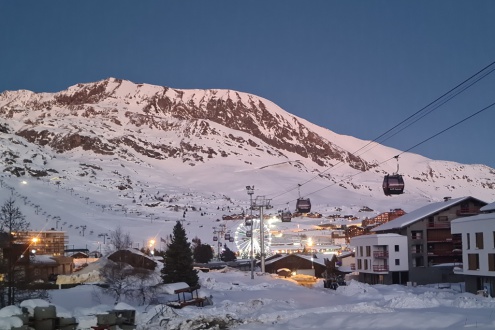Our blog:
Alpe d'Huez - one of the best all-round ski resorts in the Alps?
by Fraser Wilkin, 28 January 2022
When it comes to the giants of French skiing, most people wouldn’t look far beyond the resorts of the Tarentaise, home to some of the biggest and best-known ski areas in the world. However, Alpe d’Huez is certainly up there with the best of them, as my recent December trip confirmed.
The resort’s slightly more southerly location may have deprived it of some of the extra kudos of its Tarentaise counterparts, but its extent and variety of terrain rightly place it among the French big hitters, and not just for advanced skiers, but also for beginners and intermediates alike.
What’s more, Alpe d’Huez has several extra wow factors that set it apart from its more well-known neighbours…
A bit of geography…
Alpe d’Huez is often incorrectly assumed to be in the southern French Alps - no doubt as aspects of its environment (such as vegetation and climate) have more in common with southern French resorts. However, situated in the department of Isere, it is technically in the northern Alps – the nearby Col du Lauteret often considered as the dividing line between north and south.
Arriving in resort...
For me, one of the great joys of a ski holiday is the moment that, after hours of monotonous motorway driving, you finally catch your first glimpse of the mountains or your first sight of snow, not to mention the exhilaration of the final climb up to resort. In Alpe d’Huez, the approach road could not be any more spectacular – its 21 vertiginous hairpins immortalised as one of the most gruelling climbs of the Tour de France.
On our visit in December, the weather made the climb even more dramatic. High pressure had led to a strong temperature inversion which had trapped cloud in the lower valleys.
Below the inversion it was cold and dark, the trees still groaning under the weight of the snow from the huge early December storms.
But about half-way up we suddenly burst through into bright sunshine and clear blue skies, leaving a sea of cloud in our wake below.
Not your typical purpose-built resort…
On arrival in Alpe d’Huez I was struck by how much easier on the eye the resort was than I had remembered – although my last visit was for just half a day back in 1996!
Although it remains a hotchpotch of architectural styles, there are very few of the high-rises of the more classic French purpose-built resorts of the 1960’s, such as Tignes, La Plagne and Les Menuires. The resort has also made a conspicuous effort to ‘smarten up’ in recent years, with most new builds conforming to a more attractive wood-clad chalet style.
The resort is certainly more vibrant and attractive than many high-altitude French resorts, with a smart central boulevard and an increasing number of high-end accommodation options.
That’s not to say that the resort doesn’t cater for all tastes and budgets - there is still of lot of basic lodging here, especially if you are self-catering - but Alpe d’Huez is clearly making a conspicuous effort to become more upmarket.
We stayed in the excellent Chalets des Neiges apartments, next door to (and under the same management as) the 5-star Hotel Daria-I Nor – both being more modern “urban chic” additions to the resort’s luxury portfolio.
Alpe d’Huez is by any standards a large resort and its accommodation is certainly far from being entirely ski-in, ski-out. However, two trans-village lifts - the Alpe Express gondola and ‘bucket’ lift (or 'panier', in French) - complete with intermediary stops ensure that you are never more than a few minutes’ walk and short ride away from the slopes.
Slopes for everyone…
With 220km of slopes and a vertical drop of more than 2000m, Alpe d’Huez has an extensive and very varied ski area, all the better of course when the snow is deep and the skies are blue - as it was in our pre-Christmas visit!
But as to who it suits best is an impossible question to answer! In my opinion, Alpe d’Huez is one of only two big-name French ski resorts (the other, Courchevel) that is equally good for beginners, intermediates and experts.
Not only does Alpe d’Huez have excellent nursery slopes, but the progression onto the next level of runs is very straight forward. The main bowls above Alpe d’Huez are as wide and gentle as they come, and criss-crossed by literally dozens of easy greens and blues.
Also, unlike many beginner’s (or near beginner’s) areas in other resorts which are confined to some shady valley floor, in Alpe d’Huez you instead have a real sense of being high up in the mountains, with fabulous panoramic views in all directions.
Alpe d’Huez also caters splendidly for intermediates with several unusually long, scenic and highly varied red runs scattered across all sectors.
The 1450m vertical descents from the Dôme de Rousses to the satellite resort of Oz-en-Oisans are particularly rewarding and, in good snow, confident intermediates will also enjoy the famous 16km-long Sarenne black run from the summit of the 3330m Pic Blanc (only the very top of which is of genuinely black gradient).
We found the pistes in Alpe d'Huez relatively uncrowded during our visit, but if you find yourself wanting to get away from the masses, make sure you spend at least one day over in Auris-en-Oisans. The slopes are often deserted here and the wide, open terrain lends itself perfectly to refining your technique.
As to black runs, Alpe d’Huez has one of the widest choices in the Alps. As is common in many resorts, some are not quite worth their grading, but many are undeniably challenging.
Not all the classic blacks in Alpe d’Huez were open during our pre-Christmas visit, including the 'Tunnel' - one of the most feared pistes in France - which descends from the top of the Pic Blanc.
Another that was closed during our trip, but that all the locals rave about, is 'La Fare' - a less terrifying yet highly enjoyable, and partially tree-lined descent from the Alpette sector to the charming outpost of Vaujany.
Most famous of all, however, and one that we did manage to ski repeatedly was the 'Sarenne', a magnificent descent from the 3330m Pic Blanc through the spectacularly scenic Gorges de Sarenne.
Alpe d’Huez also has huge off-piste potential when conditions allow, not least off the back of the Pic Blanc where descents of over 2000m vertical are possible down to the village of Vaujany.
For those who can't get quite enough skiing in during the day, Alpe d'Huez also offers floodlit skiing twice a week (on Tuesdays and Thursdays) on its Signal piste. When we were here this piste was also host to the Mogul Ski World Cup.
Adrenaline-seekers can also take advantage of the resort's snowpark, and aspiring younger thrill-seekers may enjoy the tamer fun parks ('espace ludiques') - like the 'Ferme de Marcel' - where they can get a taste of half-pipes, tunnels and rollers.
The 'Sarenne' - longest black run in the Alps...
Before setting out on the 16km long Sarenne run, don’t forget to visit the viewing platform at the top of the 3330m Pic Blanc. It is said that you can see a third of France from here on a clear day. That certainly seemed plausible on our visit, when there was not a cloud in the sky, and we could make out Mont Blanc to the north, Mont Ventoux to the south and the volcanic summits of the Massif Central some 250km away to the west.
The Sarenne starts on a steep, open north-easterly facing slope which used to be mostly glacier and offer summer skiing before succumbing to climate change (like so many other summer ski areas).
It is this steep top section which really gives the run its black status but, in good snow conditions, it is far from terrifying, and easily manageable by a confident intermediate taking their time and picking their moment between each emptying cable-car.
As you descend below the glacier, the run opens up with sweeping views across the valley towards Les 2 Alpes and the Massif des Écrins, before plunging into the shady Gorges de Sarenne and winding its way towards the bottom of the underused but highly recommended Auris-en-Oisans sector.
This last section becomes a flattish cruise (boarders beware!) but had a strikingly Narnia-like feel to it during our December visit when the sun was still off-limits and the trees were caked in snow.
No shortage of mountain restaurants...
Alpe d’Huez has no shortage of enticing mountain restaurants scattered around its ski area. Two recommendations that we stumbled across in our December visit were: 'L’Île d’Oz' above Oz-en-Oisans 1350, with magnificent views down the valley – an ideal lazy afternoon pit-stop for soaking up the rays from the comfort of your deckchair.
We also enjoyed the rustic 'L’Aventure', also in the Oz sector, with its cosy interior complete with roaring fire.
If you’re heading here for lunch, bear in mind that the sun disappears from its large terrace shortly after 2pm early in the season! However, when we found this out and it started to pretty chilly, the friendly staff were quick to rush out with blankets and offer to move us to a table inside...
We were also pleasantly surprised by the number of picnic benches dotted around the ski area, some of which are marked on the piste map...
Snow conditions may be better early in the season, but good skiing is still possible later on...
Alpe d’Huez has a good combination of good altitude and decent natural snowfall, but its one major weakness is its orientation - most of the local ski area faces south and gets the full force of the sun.
This isn’t an issue early in the season – in fact the sun can provide welcome relief in colder weather – but later in the season it can be a problem if you don’t plan your day’s itinerary with care.
Late in the season, any ski area is subject to freeze-thaw cycles, but this process just happens quicker and earlier in the day on south-facing slopes.
As the slopes directly above Alpe d’Huez are pretty much all south-facing, in March and April (and even in February if it’s warm) the slopes will be rock hard first before turning slushy quite quickly during the morning.
In between there will still be a window of “good snow”, but that window will become increasingly short towards the end of the season.
But that’s far from whole picture. With careful planning, Alpe d’Huez can still offer plenty of good skiing in March or even April.
While the local slopes are mostly south-facing, there are several shadier north (or north-ish) facing slopes elsewhere in the ski area, most of which are within easy reach.
One such shady area is above Oz-en-Oisans where, despite it being much lower, the snow stays firmer longer in spring than it does above Alpe d’Huez. Another is on the under-used northern side of the Auris sector above the Gorge de Sarenne.
If you’re an advanced skier, a good guide will also be able to find you any number of shadier descents. All of these will be emptier than elsewhere in the Alps, thanks to Alpe d’Huez not being the first resort that will have sprung to mind for late season skiing among the masses!
Lots to offer skiers and non-skiers off the slopes...
Off the slopes, Alpe d’Huez also has an impressive range of facilities including an ice-rink and a sports centre complete with indoor and outdoor swimming pool, climbing wall, fitness suite and even an 8m high indoor adventure course. There are also several winter walking trails, including some at high altitude accessed by pedestrian-friendly lifts, and a 2km toboggan run.
Not surprisingly for a resort of this size, Alpe d’Huez also has a vibrant après-ski scene, with the action starting up the mountain at the famous Folie Douce with live music and cabaret, before continuing back in town at the British-run Underground Bar, Smithy’s Tavern, the Offshore Café or O’Sharkey’s.
The resort also offers a wide choice of restaurants options, ranging from gourmet dining at the 5-star Hotel Au Chamois d’Or at the top of the resort, to the more modest but charming Au Grenier back in the centre.
A true all-rounder...
So, if you’re looking for a ski holiday in one of the big French ski resorts, don’t ignore Alpe d’Huez!
As a true all-round ski resort with a large and varied ski area, it has a huge amount to offer all levels of skier or boarder. The village is also less obtrusive than many other purpose-built resorts, and much less exclusive, often offering much better value than many of the big-name Tarentaise resorts (like Val d’Isère, Courchevel and even Val Thorens) with which it competes for skiing market share.
Make sure to go to Alpe d’Huez early to mid-season for the best chance of good snow, or to plan your skiing day carefully later in the season!
Alpe d'Huez: key facts
|
Resort height: |
1860m |
||
|
Slopes: |
1100-3330m |
||
|
Pistes: |
250km |
||
| Green | ● | 31% | |
| Blue | ● | 28% | |
| Red | ● | 25% | |
| Black | ● | 16% | |
|
Further info: |
|||
With thanks to Alpe d’Huez, Les Chalets des Neiges, Hotel Daria I-Nor and Ski Set...
If you enjoy reading our content - please feel free to support us:


